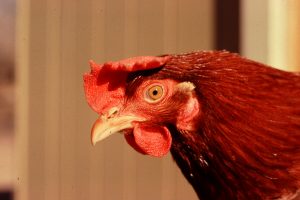Anyone who consistently shares tasty kitchen scraps with their chickens knows how eager the flock is to dine on pizza crusts, wilted lettuce, or even scraps of rice recovered from the sink strainer. Chickens enthusiastically greet a person approaching with treats. But how do they know they are about to enjoy a snack?
Chickens aren’t dumb bunnies. They’re smart. All they need to do is see a person carrying a bowl or small bucket with treats once or twice and every time they see it again, they’ll know the dinner bell’s ringing. With great enthusiasm they’ll rush out to greet their human benefactor. Chickens have brain power. People may forget things but their chickens won’t.
Being smart helps, but it takes more skills to find food and safety. If it seems that chickens can see better than humans……they can. Their vision is truly excellent. When combined with flock behavior they rarely miss anything, good or bad, that happens around them.

Having “eagle eyes” isn’t just a figure of speech. Birds enjoy excellent vision. From hundreds of feet up in the air a hawk can spot a tiny mouse, go into a steep dive and precisely close its sharp talons around the hapless animal.
Birds always watch. Anyone who’s filled a wild bird feeder that’s been empty for weeks is likely to be amazed at how quickly chickadees appear to feast on seeds. From a distant branch they saw lunch coming. Chickadees, chickens, and many other birds combine impressive cognitive behavior with outstanding vision to find food and escape enemies.
Researcher Arin Underwood studies bird vision in Alaska and learned that some species can see in the ultraviolet spectrum invisible to people. This helps a raptor see mouse urine on snow. That’s valuable. here there’s mouse urine there are mice, and nothing is as tasty to a hawk as lunch of a tiny rodent. So, the hungry bird just needs to hang out for a while near a place with urine, and eventually a tasty animal will appear.
Chickens share outstanding eyesight with other bird species. Underwood explains that chickens have tetrachromatic vision, meaning that they have four cones in their eyes, enabling them to see colors better than many mammals, including people. It’s true. Chickens see better than people. That ability helps them discover tasty bugs and seeds and spot an approaching person bearing a bowl of snacks.
There’s more to chicken vision than acuity. It’s flock behavior. A single hen foraging in a backyard has but two eyes. She needs them to seek tasty food and scan for predators that might want her for lunch. That’s a lot for two eyes to see. In contrast, a flock of ten hens on the same lawn has 20 eyes. Odds that a lone bird will spot a stalking fox or hovering hawk are small, but when ten birds are constantly watching it’s likely one or two will see a dangerous interloper, squawk a warning, and send the flock scampering to safety. Outstanding chicken vision has caused many foxes to go hungry.
Chickens are far from simple minded barnyard animals. Their eyes may be small, but their powerful vision and memory help them find food and avoid danger. They are backyard friends and feathered wonders.